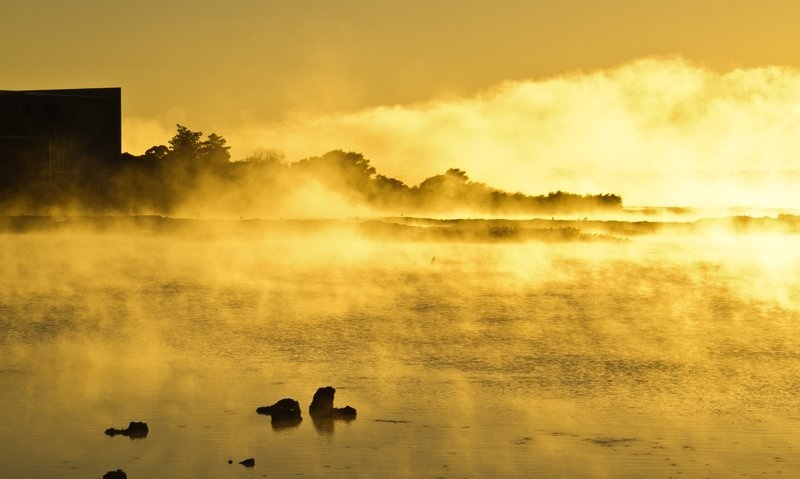What lies beneath Lake Rotomahana
What lies beneath?
What lies beneath is the type of tag line that horror movie makers love – it fuels images of monsters lurking in the depths and generally leads to a heightened state of awareness – okay so what does lurk beneath??
When we apply that same question to Lake Rotomahana, the answer is less fear inducing and more astounding, in a natural way.
The Tarawera eruption of 1886 changed the surrounding area significantly and in the process made Lake Rotomahana much larger. That in itself is a fascinating phenomenon. However, combine that with the mass of geothermal activity happening under the lake and we go instantly from interesting to the scientific equivalent of a “super happy place”.
In its current, post eruption state Lake Rotomahana holds many secrets; namely the location and state of the famed Pink and White Terraces and the potential, power and potency of geothermal heat within the lake.
Hot equals large power potential
Scientists studying the large, active geothermal system under Lake Rotomahana found that some measurements were showing almost 90W per square metre of heat energy.
This level of reading was a first for one of the scientists involved in the project who stated:
"In my career as a scientist studying heat flow, I really have not seen anything this strong."
This type of discovery acts to further fuel our interest and fascination with the power, resource and potential in both the lake and the overall geothermic/volcanic nature of the surrounding area.
Sampling process using thermal blankets
Conducting the survey, project scientists form GNS Science, led by Cornel de Ronde, undertook an extensive sampling process that involved the use of a new technology, thermal blankets. Each blanket is equipped with a thermometer on the top layer of the blanket and a second on the bottom layer of the blanket.
In total, ten blankets were used in 100 different sample areas and this project marked the first time the thermal blankets were used in a lake setting.
To deploy the blankets, team members lowered each individual blanket over the side of the boat, carefully removing any air bubbles and finally hand lowering to 100m – the process taking around 5 minutes per blanket. A float was then placed on top of the blanket to note location and allow easy retrieval 24 hours later, that same blanket is then taken to the next sample station.
All that hot water must come from somewhere?
Project leader de Ronde said that one of the areas of high heat flow was near the western end of the Lake, where the famed Pink Terraces used to be before the 1886 eruption of nearby Mt Tarawera, this meant the hydrothermal system there had carried on since the eruption.
While work was still being done to establish the source of the heat, de Ronde said "there has to be some sort of volcanic heat sources underneath” and "the heat-flow series proves that there is a lot of heat passing through the bottom of the lake."
Being that the lake sits above the Tarawera - it stands to reason that the heat source is related to some magma body underneath the lake.
And while Bay of Plenty residents know that their area is hot (as in what's hot and what's not) the results of this study can add to the scientific understanding of the size and state of the magma body underneath this part of the Bay of Plenty, potentially making it even “hotter”... in metaphorical terms that is.
With this information a comprehensive story could then be put together about the evolution of the volcano-geothermal system since the 1886 Mt Tarawera eruption.
Maurice Tivey, a senior scientist with the Woods Hole Oceanographic Institution in the US, which is involved in the research, said "This is an incredible amount of heat coming out of the bottom of the lake."
Let us digest and regress
With this amount of heat in the lake and the fact that Lake Rotomahana is within the Okataina Volcanic Centre, between Rotorua and Kawerau, where volcanoes tend to erupt every 700 to 3,000 years, the interest in the Lake and Mt Tarawera's evolution since the 1886 eruption seems logical. Let’s not wake the sleeping monster but be conscious that it is sleeping.
According to GNS Science, eruptions in the Okataina Volcanic Centre can be between 100 to 10,000 times larger than the more common eruptions at White Island or Ngauruhoe.
The Tarawera eruption was one of the smallest in the Okataina Volcanic Centre over the past 21,000 years.
Ominous?
Did I mention horror film makers at the beginning of this?
Do the faint correlations of the area/lake sound familiar to anyone – rising lake height/size and increased water temperature – boom... volcanic eruption in Dantes Peak.
Hollywood loves to take scientific certainty and mix it with innate human fear to create films of tension and climax.
If Mt Tarawera and Lake Rotomaha were a film what would its next scene be?









Connect with Us
Facebook YouTube Instagram Tripadvisor Blog Email